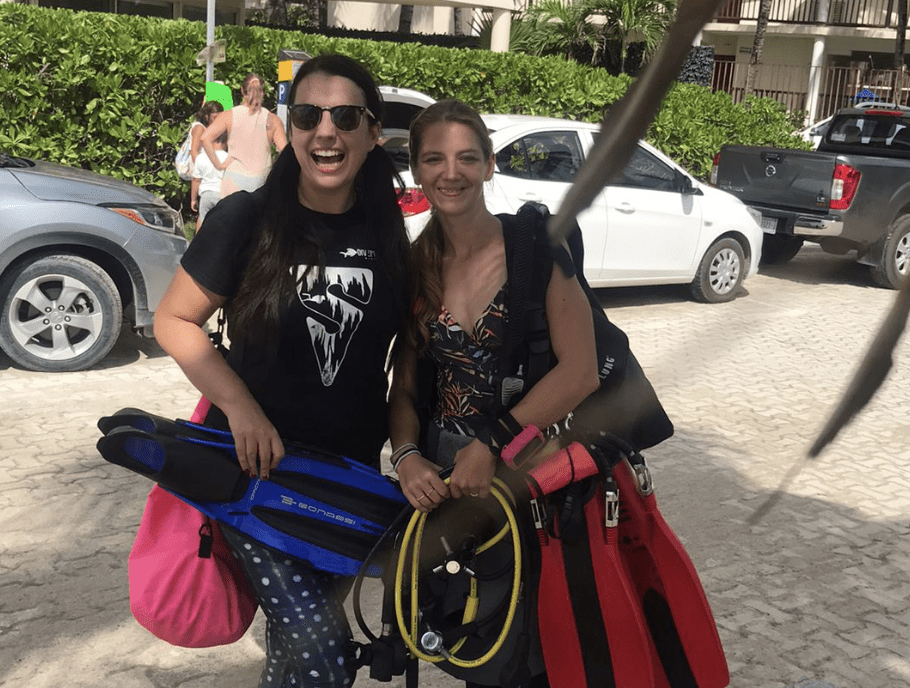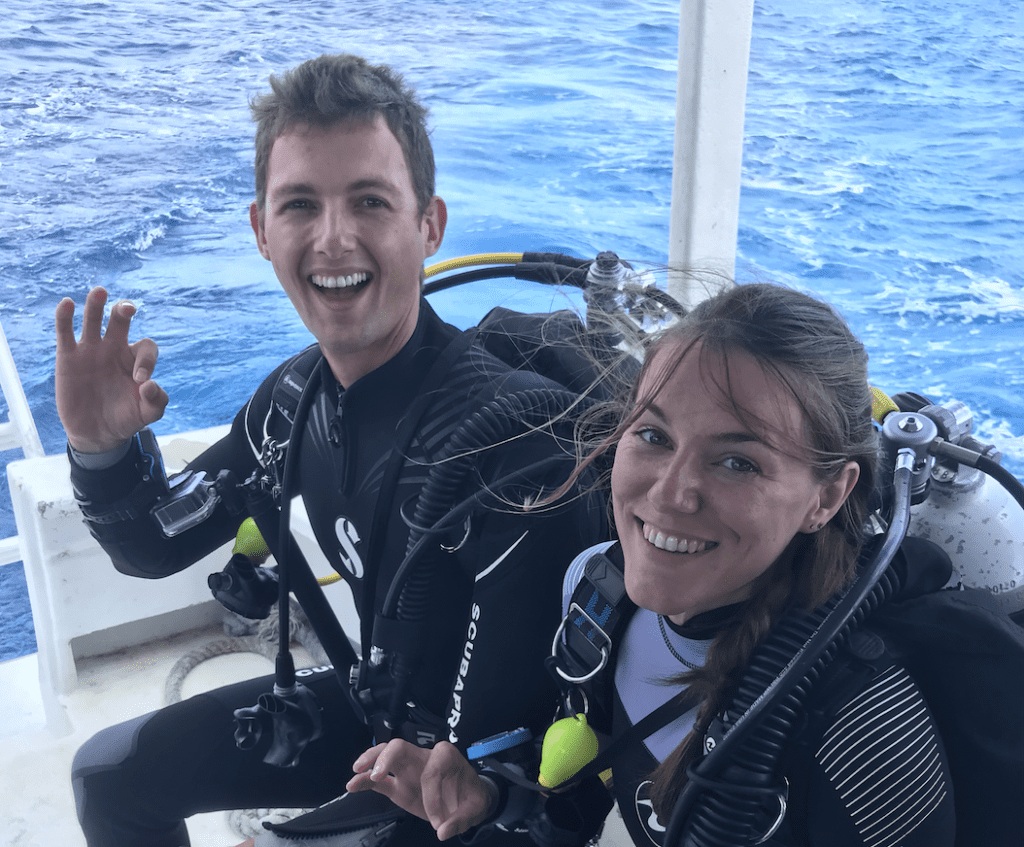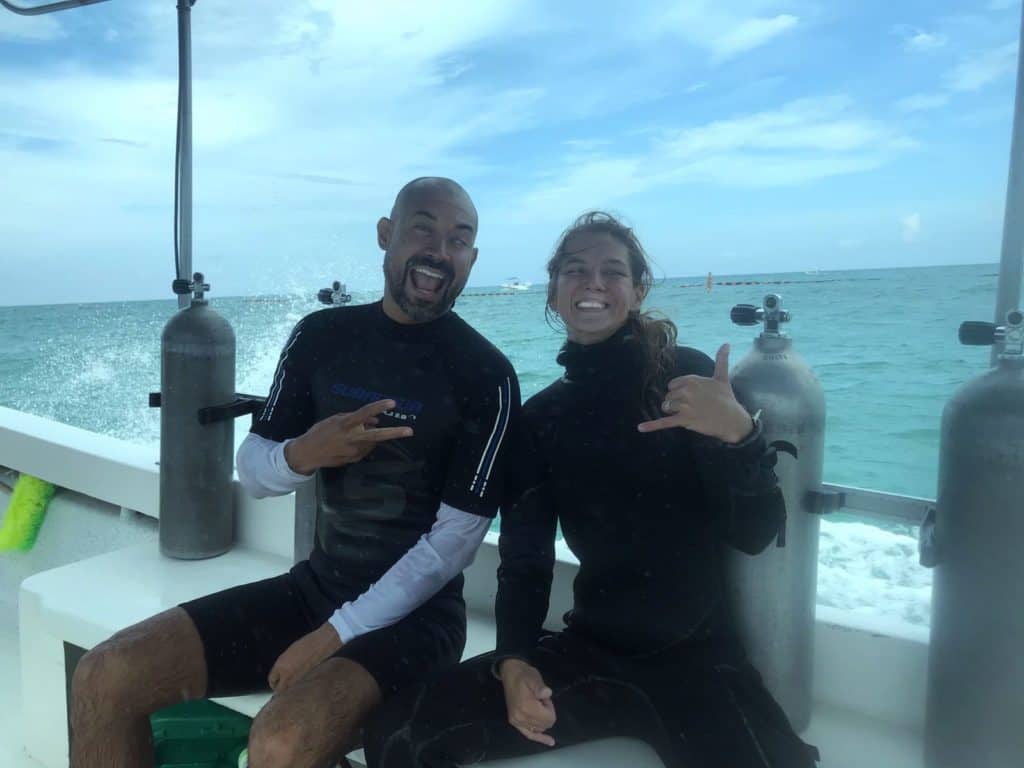Scuba diving is a sport that’s rarely done alone. In fact, for recreational diving, you should always go with a dive buddy. Being a good dive buddy is more than just being a friend to dive with, but you are also responsible for the safety and making the dive enjoyable too!
Top 13 Tips to Be a Good Dive Buddy
When you learn to dive you learn almost immediately about the buddy system. This is made to ensure that diving is safe and fun! A good dive buddy is someone who you will share your diving experience with, but they are also your go-to to prevent emergencies and solve problems if and when they occur.
From my many years of diving across the world, I’ve been paired with a whole range of buddies, some of who were great, and others who made my dive almost unenjoyable. So I’ve made this blog to help you avoid some of the situations I’ve been in and help everyone have the best dive possible.
13 Ways to be a Good Buddy when Scuba Diving
Having a good dive buddy starts with BEING a good dive buddy. So I’ve compiled this list of tips to make sure you, and whoever you dive with have the most enjoyable diving experience!
#1 – Get To Know Your New Buddy
Often when you dive, you only meet your buddy on the day of the dive itself.
Your first step in being a good buddy underwater is to be a good buddy above it too! Get to know them. Simple things, like their name and where they are from are great to start.
You can also ask them about their diving experience. Share your certification level, how many dives you’ve been on, and maybe some fun anecdotes from previous diving experiences you’ve had.
The point is to build a rapport, ready for when you’re underwater and communication is a little trickier. Be engaging with your questions and don’t forget to smile to help them feel at ease! Diving is meant to be fun for both of you, so start on shore.
Some people often moan about being put with a ‘newbie’ diver, or if you’re the newer one, it can often feel a little overwhelming when paired with a very experienced diver. Both have their pros and cons. Newbie divers, while they may need a little more support with remembering procedures and spotting marine life, have a contagious enthusiasm that is always fun to be reminded of. Experienced divers are great too, you can learn so much from them!
The main thing to remember when getting to know your dive buddy is that it isn’t a bragging competition! Nobody wants to be bored with the thousands of dives you have or to hear endless tales of what you’ve seen on dives. Keep the communication flowing and the rapport will grow too.

#2 – Plan your Dive together
Before you jump in you need to make a dive plan, and do it together. You need to take into account your buddy’s limits. If they are an open water diver, don’t make a plan that would take them past the 18m depth they are certified to go to.
Create your dive objectives first, and plan your limits, along with a route and your maximum depth.
As well as the dive itself, also plan your connection. Different divers have different preferences when they dive. Some like to check regularly in with a buddy, with visual signals, while others are fine with a glance to check all is good. A lot of the time this will depend on the visibility and strength of the current too.
If you’re diving with someone who is focused on underwater photography, for example, they may be slower and not want as many interruptions while trying to capture a good image. But they may want to be advised if you see something super cool, like a strange nudi, or hard-to-see worm.
If you communicate all of these details and limits before the dive, it makes the actual dive more pleasant for everyone.
During a recreational dive in more touristy areas, it’s more likely a Divemaster will create a plan of the dive sites and give a briefing to you, but still listen closely to the route and depths. Then, with your buddy, you can still plan other things like closeness, how to check on one another, and personal dive objectives too.
#3 – Communicate Well
So once you’ve developed a rapport, take your communication to the next level. The great thing about diving, is the hand signals used underwater translate into any language and are known globally.
Go over all of the common dive hand signals you should both know:
Are you okay?
How much air do you have?
Safety Stop
It’s also important to remember how to explain how much air you have – it can be different if the other person is used to bar, and you have psi.
As well as the common signs, make sure you also practice for any emergency situations too, such as:
-Out of air
-Share air
-Let’s end the dive (Remember any dive can call a dive at any time, for any reason! Safety first!)
When I dive I also have some fun silly made-up signs that I used too, including a new buddy in these can make them feel welcomed in the enjoyment!
My personal favorite ‘fun hand signals’ include a rainbow-style hand shimmy when I see an amazing school of fish, and one buddy and I have been known to do a full underwater version of ‘baby shark’ with the actions!
When you have a dive partner you dive with regularly communication gets easier, as you can often tell, even behind a mask and regulator, how they are feeling and from their facial expressions how they are.
If you are worried about communicating something difficult underwater, you can always take a slate for communication too.

#4 – Complete a Pre-Dive Buddy Check
Before getting wet, it’s essential to perform a pre-dive safety check. The one I always use is BWRAF, and I use the acronym Because We Really Aren’t Fish, as it helps me to remember, but you may have your own!
B – BCD/Buoyancy: Make sure everything is connected and functioning properly. Test the inflator button by inflating your BCD and deflate using the different valves. As well as checking your own gear, know how to do this on your buddy’s BCD too, in case of an emergency.
W – Weight: Ensure your weight belt is on, or weigh pockets filled and that they are secure. Nobody wants to get to the water to find out they can’t sink, or worse, to lose a weight pocket to the deep. You should make yourself familiar with how your buddy’s weights are released for any emergencies too.
R – Releases: Releases are another name for the clips that fasten your BCD together. On most standard jackets there are 4, make sure you check they are fastened and secured before entering the water, but know how your buddy’s operate, especially if they have a model you aren’t familiar with, such as a wing-style BCD.
A – Air: Check your tank is fully open and take some breaths from your regulator while checking your gauge. Also, check your octopus too, and make sure it is in an easy place for your buddy to grab in an emergency.
F – Final Check: Have you got everything else? Fins / mask / camera. Any final questions? Do that all here.
It’s important to do this carefully, especially with a new buddy as other people’s equipment can differ. Also explain your equipment too, especially if you have an unusual BCD etc.
#5 – Follow Your Dive Plan
Once you’ve made a dive plan – stick to it! There’s nothing more disconcerting underwater than a buddy randomly taking off in another direction or acting in a way off plan. Not only can it be confusing for your buddy, but sometimes it can be dangerous.
Especially for less experienced buddies, stick to more conservative limits. If you see a patch of coral that’s a bit deeper, but your buddy can’t go, just don’t go. You can always make a plan to dive the site again another time.
Sometimes you may need to change the plan underwater, for safety reasons, but be clear and communicate this with your buddy so you’re both on the same page.
Safety comes first, always, and if you behave recklessly, your buddy could choose to end the dive early, rather than stay beneath the water with you.
The same goes for you if you are with a buddy that isn’t diving safely and is making you feel uneasy, you can always cancel a dive at any time, for any reason.
#6 – Stay Close To Your Buddy
How close you stay to your buddy will usually depend on the conditions. Think about current and the visibility, which can change on a dive too.
During your plan, you might have decided how you’ll travel along the reef. Some prefer a side-by-side approach, and others one behind the other. Just don’t be so close that you’re on top of them, or are bashing into them.
If you’ve planned to check on each other at regular intervals, remember to do it on the dive. As a rule of thumb, you should always be close enough so that you can respond quickly if your dive buddy needs immediate help.
#7 – Respect Your Environment
When you are underwater you are an ambassador for the ocean, so remember to treat the area when your dive with respect. Protect any creatures you see and the corals too.
You can be a good buddy by supporting them if you see them
If they are low to the ground and their fins are kicking the coral or silting up the water by kicking up the sand, let them know. It makes the dive site more pleasant for everyone!
If you see they have a rouge SPG or their octopus is dragging along the floor, tell them, or help them to tuck it to a more secure place.
This one can be tricky to deal with, but if you see your buddy poking or interfering with marine creatures or fish, tell them. A gentle wiggle of the finger to remind them not to touch is usually all it takes.
#8 – Have Fun on the Dive
The main purpose of most recreational dives is to have a lot of fun, and with a safe buddy this is easily accomplished!
Remember to point out interesting things to one another. There’s nothing worse than surfacing to everyone else chattering excitedly about the bullshark, eagle ray or turtle they saw, if you didn’t see it too. So share it with your buddy.
Your buddy will share what they see too, and remember to be grateful of this too. Even if you have seen a lobster so many times, for them it can be exciting! Smile with your eyes and acknowledge what they have shown you.
You may also want to just be a little silly too. Blowing bubble rings and enjoying the benefits of neutral buoyancy by spinning around can be oodles of fun. These are good to do just before a safety stop, so you aren’t having a detrimental effect on your air consumption.
Although silly fun is nice, don’t go too far with any practical jokes underwater, especially those that could put you or your buddy in danger.

#9 – Dive Safely
Remember the main priority of every dive is that every diver returns to the surface safely. Nobody wants to be with a buddy that’s dangerous, and your partner may even decide to end the dive if they feel you are unsafe to dive with.
Always ensure you both get back to boat or shore together safely. Don’t lose your buddy on the way!
#10 – Share Feedback about the Dive
After you’ve surfaced on a dive and are back in the comfort and safety of the boat, or on dry land, depending on your dive site, you can talk to your buddy about anything that happened on the dive.
It’s always nice to talk about the interesting things you saw. You might be able to share the names of some critters that are new to your buddy, or learn from them too.
There may have been some problems on a dive too, and it is important to discuss them too, but in a calm and fair way. Everyone is always learning as a diver, and each situation is unique, with weather, sites, and currents affecting what goes on below the waves.
If you and your buddy ran into a problem, talk out how it went and make a plan for how you could prevent that problem in the future.
If there was a serious issue caused by your buddy underwater, you need to share this too. This can be a difficult conversation to have, but it will help your buddy not to make the same error when diving again. Remember to be honest but fair when talking and don’t lecture or shout at your buddy. Everyone has a bad dive at times!
Unless you are a dive professional avoid critiquing the skills of other divers. But if you do see anything glaringly obvious, you may want to guide them towards a specialty course to help them improve their skills.
Also, be aware of your own feedback, your buddy might have something to share with you too. Listen carefully and accept what they share.
#11 – Fill In Your Logbook Together
It’s always best to fill in your logbook straight after a dive, while the information is fresh in your head. And two brains are better than one.
You can remind each other of the critters and wildlife you spotted and share any issues or troubles you might have encountered.
Sign each other’s logbook too, this is also important if you will be continuing your learning and doing other courses in the future.
#12 – Share Pictures of Your Dive
If you have an underwater camera on your dive, share the pictures you take with your buddy via email or on social media. Don’t forget to get their credentials to tag them if they want to.
Good dive buddies can become friends for life, and if you find a great one, it can be useful to stay in touch to dive again together.
#13 – Keep Learning!
Nobody is perfect, and in diving, it is a sport where we are always learning.
Every dive is different and every day you might experience something new. Take every experience and let them help you develop into being a better buddy.
You can also enroll in courses to help you become a better diver. The PADI Rescue course is the first that helps you recognize issues when diving and many divers feel like they become a far better diver and are more aware of how to support the divers around them after completing it.
Come and Dive with DivePoint
If you want to put your dive buddy skills to the test, or maybe you don’t have a buddy and are looking to meet new dive friends, come and dive with us at DivePoint!
Not only can we show you the amazing oceans of Playa del Carmen and Cozumel, we can also show you the magical cenotes of the region, or take you for an encounter with bull sharks!
Don’t delay, book your scuba package with DivePoint today.


